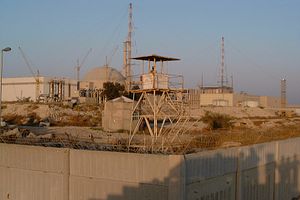The former head of Israel’s nuclear agency says that Iran is at least a decade away from acquiring an operational nuclear weapon.
According to Israeli media outlets, Brigadier General (res.) Uzi Eilam, who served for ten years as the head of the Israel Atomic Energy Commission, said that it would take Iran a decade to acquire a nuclear deterrent, and it might not even be seeking one.
“The Iranian nuclear program will only be operational in another 10 years,” Eilam said Ynet News reported. “Even so, I am not sure that Iran wants the bomb.”
Eilam said he based his assessment on his long history of working on Israel’s atomic and missile programs. “From being involved in many technology projects, I have learned the hard way that things take time,” Eilam said.
He also went on to say that the interim nuclear deal Iran signed with the P5+1 powers was significant in reducing Iran’s breakout capacity. “According to reports, the steps Iran has taken are most significant, the primary step being the dilution of more than half of its enriched fuel.”
He continued: “The main issues [for a diplomatic solution] are still ahead of us, but it is definitely possible to be optimistic. I think we should give the diplomatic process a serious chance, alongside ongoing sanctions. And I’m not even sure that Iran would want the bomb – it could be enough for them to be a nuclear threshold state – so that it could become a regional power and intimidate its neighbors.”
Eilam has a long history in the Israeli security establishment. Beside his stint as Israel’s atomic chief, as well as his military experience, Eilam has served as the Chief Scientist and Director of R&D in the Ministry of Defense. He also held positions in the Office of the Prime Minister, as well as in other parts of the MoD.
Eilam’s assessment about how far away Iran is from a nuclear arsenal is likely correct, although it’s important to understand what he actually said. At first glance, his statement seems to grossly contradict the most recent public intelligence assessments of Israel and the U.S., which predict that Iran could acquire a nuclear capability as soon as 2015 (the assessments are slightly dated at this point, and came before the nuclear deal however).
But part of this discrepancy is due to different definitions of when Iran would become a nuclear state. This should not be a surprise as the question of when a state become a nuclear weapons power is somewhat ambiguous. Moreover, as Jacques Hymans has pointed out, how one answers this question has “significant implications for proliferation assessment, analysis, and policy.”
Many Iran hawks, including Israeli Prime Minister Benjamin Netanyahu, insist that Iran would become a nuclear weapon state once it had acquired the necessary fissile materials (highly enriched uranium or reprocessed plutonium) for a nuclear device. In some ways, this makes sense as once a state can indigenously produce the fissile material, it becomes extremely difficult for foreign powers to deny them the ability to construct a nuclear device. By this standard, however, a country like Japan would qualify as a nuclear weapon state. Indeed, according to the U.S. intelligence community, Iran more or less has this capability already, even if it hasn’t actually produced the fissile material yet.
On the other hand, from what is public about the assessment of Western intelligence agencies, they appear to assess that Iran would become a nuclear weapons state once it had assembled a nuclear device. By this standard, North Korea would be considered a nuclear weapon state despite its apparent inability to deliver a nuclear warhead.
Eliam’s statement refers to the time it would take Iran to develop an operational nuclear arsenal. At the very least, this would mean when Iran is capable of reliably delivering nuclear weapons, which would almost certainly be in the form of nuclear-tipped missiles (He could also mean when Iran has a secure, second strike capability, although this seems less likely).
In that sense, Eilam’s prediction is not implausible by any means. After all, North Korea conducted its first nuclear test eight years ago and it has yet to demonstrate it has an operational nuclear weapons capability. Moreover, Iran’s nuclear program has progressed even more slowly than North Korea’s path to the bomb.
Furthermore, it’s worth noting that official U.S. and Israeli intelligence assessments, as well as comments made by senior government officials, have consistently grossly overstated how quickly Iran’s nuclear program would advance. For example, in 1992 then-Israeli parliamentarian Benjamin Netanyahu said Iran could produce a nuclear weapon within three to five years. The same year, Israeli Foreign Minister Shimon Peres said Iran would be a nuclear weapon state by 1999.
Similarly, a task force of the House Republican Research Committee predicted in 1992 that “98 percent certainty that Iran already had all (or virtually all) of the components required for two or three operational nuclear weapons.” Around the same time, then-CIA Chief Robert Gates said Iran’s nuclear program could be a big problem in five years.
Far from revising these assessments downward, The New York Times carried a report in 1995 that cited unnamed Israeli and U.S. senior officials as saying that “Iran is much closer to producing nuclear weapons than previously thought.” Of course, when asked how close Iran was at that time, the officials said about five years.
































